Intersex youth deserve an educational environment which helps them develop their full potential and make them feel included, safe and free from harassment and discrimination. They deserve school programs which promote bodily and personal diversity as an added value.
Sadly, this is not the reality in Europe today. On the contrary, they are often subjected to harassment, bullying, verbal and physical attacks, offensive and threatening comments, and receive poor or negative information about bodies like theirs.
It is high time to put our EU Charter of Fundamental Rights into practice, especially the right to human dignity (Article 1), the right to education (Article 14) and the right of the child to such protection and care as is necessary for their well-being (Article 24).
Therefore, we call on all the EU Member States to:
- Take all necessary legislative, administrative and other measures to ensure equal treatment of students, staff and teachers within the education system, without discrimination on the basis of sex characteristics;
- Ensure that laws and policies provide adequate protection for intersex students, staff and teachers against all forms of social exclusion and violence within the school environment, including bullying and harassment;
- Ensure that students subjected to such exclusion or violence are not marginalised or segregated for reasons of protection, and that their best interests are identified and respected in a participatory manner;
- Ensure inclusion of comprehensive, affirmative and accurate material on sexual, biological, physical and psychological diversity, and the human rights of intersex people, in curricula, taking into consideration the evolving capacity of the child;
- Ensure inclusion of comprehensive, affirmative and accurate material on sexual, biological, physical and psychological diversity, and the human rights of intersex people, in teacher training and continuing professional development programmes.
See The Yogyakarta Principles, 2006, as complemented by The Yogyakarta Principles plus 10, 2017 which added explicit reference to the sex characteristics, Principle 16
Please download the pdf files for the best viewing experience (vector files)


Below is the content of the infographics in text format:
The 15–17 year old intersex respondents experienced…
50% …Bullying at school
Did your school education address at any point LGBTI issues?
46% No
15% Yes, in a negative way
13% both in a positive and negative way
…Harassment in the 12 months before the survey
64% for any reason
55% verbal in-person
46% due to being intersex
Number of times experiencing offensive or threatening comments due to being intersex in the 12 months before the survey
23% Once
21% Twice
18% 3-5 times
35% 6 or more times
Location of the last incident of hate-motivated harassment?
39% At school, university
Who did this to you?
50% Someone from school, college or university
Did you report this incident?
88% No
In the 12 months before the survey, have you ever felt discriminated against due to being intersex by school/ university personnel?*
54% Yes
…Violence & physical or sexual attacks In the 12 months before the survey
14% physical or sexual attacks due to being intersex
Thinking about the last physical or sexual attack because you are intersex, what happened to you?
79% physical attack
20% sexual attack or combination of physical and sexual attack
Thinking about the last physical or sexual attack because you are intersex, was the perpetrator alone or was there more than one perpetrator?
46% Alone
53% More perpetrators
What was the gender of the perpetrator(s)?
48% Male
23% Female*
23% Both male and female*
How did the last hate-motivated violent incident affect your health and well-being?
59% I was afraid to go out or visit places
56% I had psychological problems (e.g. depression or anxiety)
9% I needed medical assistance or hospitalisation*
* The results marked with an asterisk are based on a small number of responses and are statistically less reliable. Results are flagged if they are based on 20 to 49 unweighted observations in a group total or based on cells with fewer than 20 unweighted observations. (FRA LGBTI Survey Data Explorer)
Learn more here:
https://www.oiieurope.org (this page)
https://www.intervisibility.eu
Source of Data displayed: ©European Union Agency for Fundamental Rights (FRA) LGBTI Survey Data Explorer & EU-LGBTI II (2019) Survey Report “A long way to go for LGBTI equality” ISBN 978-92-9474-843-0 • doi:10.2811/667747 • TK-04-20-044-EN-N
Page updated: 11.01.2023


